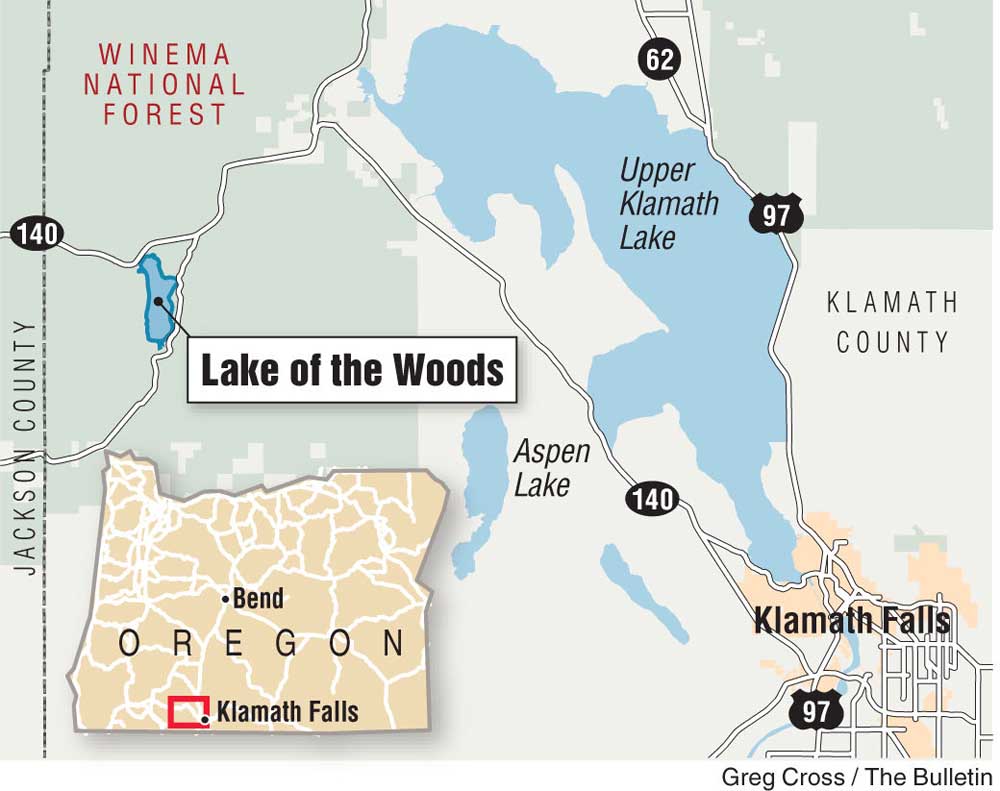Northwest Travel: A resort on the Lake of the Woods
Published 12:00 am Sunday, June 12, 2016

- Northwest Travel: A resort on the Lake of the Woods
LAKE OF THE WOODS —
Oliver Cromwell Applegate was a 25-year-old captain in the Mountain Rangers, a private militia that maintained peace and justice in the Siskiyou and Cascade mountains of Southern Oregon, when he happened upon Lake of the Woods in 1870.
Trending
Applegate, whose pioneer father, Lindsay Applegate, had helped to blaze the Applegate Trail between Oregon and California, was camped with a band of Klamath Indians on a rough track between Klamath Falls and Ashland, where he lived, when he was distracted by the singing of birds. As the story is now told, he wandered off to find the source of the sound and stumbled upon the pristine natural lake, its waters wrapped in evergreen forests beneath the lofty summit of Mount McLoughlin.
Applegate dubbed the waters “Lake o’ the Woods.” He returned to build a cabin near its south end, thus becoming the area’s first resident. And until his death many years later, in 1938 at the age of 93, he remained a regular visitor.
The Captain saw a lot of changes during those 68 years. He saw management of the forests pass from the old Cascade Forest Reserve to the U.S. Forest Service in 1908. He saw summer homes and public campgrounds built along the 6-mile lakeshore. He saw sport fishermen descend upon the lake for its abundant trout and other fish. And he saw a small resort community develop on the northeastern shore starting in 1926.
Historic resort
The resort remains, and as it approaches its 100th birthday, it’s doing just fine, thank you. The Lake of the Woods Mountain Lodge & Resort is at the heart of a community located a half-mile south of State Highway 140, 33 miles west of Klamath Falls and 43 miles east of Medford.
One guest cabin and the general store, built in 1924, survive from a devastating 1951 fire. The resort had been so successful as a fishing camp that it was quickly rebuilt. Today, in addition to 34 cabins and 22 RV sites, it manages the two Forest Service campgrounds (Aspen Point, with 60 sites, and Sunset, with 64) built on the lakeshore in the 1920s, and another smaller campground at Four Mile Lake, 5 miles north on an all-weather forest road.
Trending
Open year-round except for April and early May, when it is closed for maintenance, the resort retains a rustic feel. But it’s a delightful getaway, nearly as popular among ice fishermen (full gear rentals are available) as it is among families of water-sports lovers.
As described on the resort’s website, much of the current appearance of the property was shaped by owners Doug and Becky Neuman between 1998 and 2008. That included a major restoration and remodel during that first winter and spring. The rebuilt marina complex has 4,000 square feet of docks with 36 moorage slips, along with a dockside tackle shop that supplies top-end equipment to experienced fishermen and basic gear to novices.
A variety of boats is available for rent, from basic motorboats to pontoon boats for large parties, along with canoes, kayaks and paddle boards.
Nearby, the Marina Grill and Pizza Parlor will supply boaters with sack lunches, along with espresso and breakfast pastries, pizza, burgers and ice cream. And in the main lodge is the Lake House Restaurant, serving three gourmet meals a day through the summer season.
Its size has been doubled with the addition of a new dining patio and the moving of the lodge’s lounge to the second floor, as directed by owner John Doherty, who purchased the resort in 2008. Knotty-pine walls, hunting trophies and a Depression-era WPA mural (Klamath Indians canoeing the lake) are complemented by picture windows designed to welcome the outside in.
Overnight cabins have been a particular challenge. Each has been gutted, had its electrical wiring and plumbing replaced, then painted and refurnished with custom draperies, Pendleton blankets and old magazines on the nightstands as a nod to the 1950s. All units have their own bathrooms and kitchen areas, and 10 have gas stoves.
Guests check in at the historic General Store, where the inventory includes gifts, apparel and sundry items as well as penny candy, old-fashioned camp gear and toys from another era. As the gathering place for the Lake of the Woods community, the store hosts outdoor movies on Friday nights through the summer season, and Saturday night family barbecues with live music and dancing.
The RV sites include 12 with full hookups — electricity, water and sewer — and 10 with partial hookups. The three campgrounds are continually maintained with sensitivity to the environment of the lake area.
Active diversions
Resting just below 5,000 feet elevation in Fremont-Winema National Forest, Lake of the Woods is within 7 miles of 9,495-foot Mount McLoughlin, one of the most prominent of the Cascade peaks. A trailhead to the mountain’s summit is off Forest Road 3661 near Four Mile Lake, about 3 miles north of the resort.
There are many other hiking and backpacking options here as well, including the Mountain Lake Wilderness, just east of Lake of the Woods. Here, more than 20 small lakes nestle within glacial cirques in a cluster of four overlapping shield volcanoes. Several trails access the wilderness, including a 6½-mile track from the resort environs.
Trails such as these are the best places to embrace the lake’s natural environment. There are black bears and mountain lions in the dense Douglas fir-dominated forests, along with elk, mule deer, black-tailed deer, coyotes and bobcats, along with such smaller species as pine martens, porcupines, skunks and marmots. Multiple species of owls are commonly heard but not seen. Woodpeckers, jays and songbirds nest in the forest, and around the lake itself are many waterfowl (grebes, loons, ducks and geese), osprey and bald eagles.
Ultimately, though, the typical visitor to 1,146-acre Lake of the Woods is here for the fishing. About 2¾ miles long and three-quarters of a mile wide, it has an average depth of only 27 feet, and its deepest hole is only 55 feet. It’s no surprise that, although swimmers and water skiers are pleased with 70-degree summer water temperatures, the lake freezes over in winter.
The State Department of Fish and Wildlife manages the fishery. Red-band trout likely were the only species native to the lake, but hatchery-bred rainbow trout were introduced as early as 1913. Today brown trout (averaging 14 to 19 inches) and kokanee salmon (about 12 inches) are also stocked, and there are self-sustaining populations of brook trout, largemouth bass, black crappie, yellow perch, bullheads and chubs.
Every one of them — but especially the trout and kokanee — will be targets of anglers during the annual season-ending fishing derby, this year scheduled for Sept. 24.
Cascadian Rustic
A first stop for many Lake of the Woods visitors is the historic ranger station at the north end of the lake on Highway 140. Now serving as a visitor center, it was built between 1937 and 1939 by the Depression-era Civilian Conservation Corps, as Bend author Les Joslin writes in his book, “Uncle Sam’s Cabins.” The project included an office, residences and outbuildings, all constructed in the Cascadian Rustic architectural style and listed on the National Register of Historic Places.
Many summer homes were also built during the same era. In fact, the Forest Service documents 120 of them around the lakeshore in 1937, only 20 years after the government issues its first residential-use permit. When power lines brought electricity to the area, for the first time, in 1938, the numbers boomed again; today there are about 220 summer-only residents.
There are also three organizational summer camps on the lakeshore and a pair of day-use areas, apart from the campgrounds, for swimming and picnicking. Forest Service statistics indicate that more than 5,000 people may visit the lake on summer weekends, and it’s not unusual for there to be several hundred snowmobilers and cross-country skiers here in winter.
An unusual aspect of Lake of the Woods is that it has no true outlet. Fed by a single year-round stream (Rainbow Creek), two seasonal creeks and groundwater seepage, the lake’s only exit is the Great Meadow, along Highway 140 on its north side. Snow-covered in winter, this is an especially popular place for cold-weather outdoors lovers to congregate, especially with its highway access. When the snow melts, however, Great Meadow drains into appropriately named Seldom Creek, which eventually makes its way into Upper Klamath Lake.
Lake of the Woods’ use and accessibility have made it a popular location to observe the effect that visitation has had — and will potentially have — on its environment and water quality. Beginning in 1972 with a group from Oregon State University, followed by other colleges and federal agencies, the lake has been a regular study subject.
The studies indicate the lake and its ecosystem are faring well, despite some early shoreline erosion in the summer-home areas. This has led the Forest Service to take the precautionary steps of encouraging cabin owners to install new septic systems and use low-phosphate detergents. A soil-conservation program and road drainage improvement projects were also initiated, and homeowners have been prohibited from removing naturally fallen trees from the shoreline even as they plant new native vegetation there.
— Reporter: janderson@bendbulletin.com.








